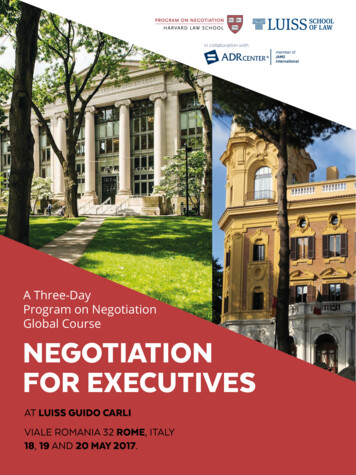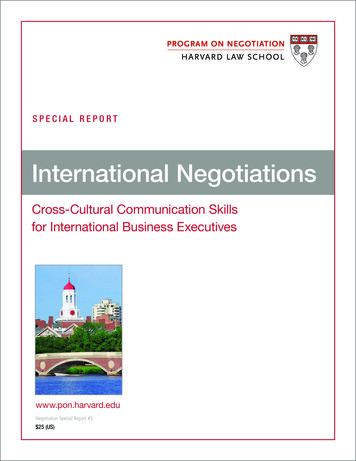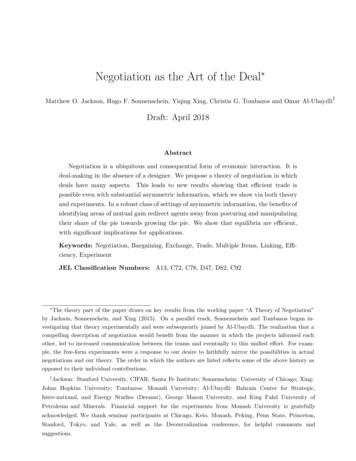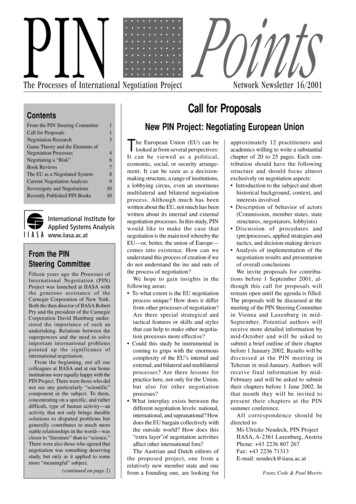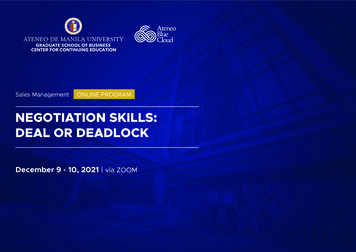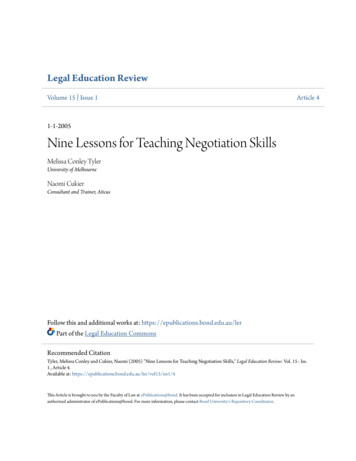
Transcription
APPENDIX 12B*NEGOTIATION AND RISK MANAGEMENTIN THE REAL ESTATE CONTRACTINGPROCESSAPPENDIX OUTLINEIntroduction12B.1 Underlying Negotiation Philosophies: Two Views12B.1.1 The Competitive Approach: I Win if YouLose (Win-Lose)12B.1.2 The Ally, Mutual Gains, or CooperativeApproach: We All Can Win (Win-Win)12B.1.3 Principled Negotiation and Efficiency:The Concept of Pareto Improvement12B.1.4 Factors Influencing the Degree ofCooperation Versus Competition inNegotiation Styles12B.2 The Process of Negotiation12B.2.1 The First Step: Preparation12B.2.2 In the Thick of It: How to Continue12B.2.3 The Letter of Intent or Understanding12B.2.4 Finalizing the Deal12B.3 Tricks of the Trade: Other Techniques andConsiderations in Successful Negotiation12B.3.1 Information and Knowledge Are Power12B.3.2 The Role of Communication Skills inNegotiation12B.3.3 Avoid Conflicts of Interest Within theSides12B.3.4 Multiple Issue Negotiation and AgentPrincipal Communication12B.3.5 Patience Is Important12B.3.612B.412B.5Stay Objective and Know Your TrueInterests12B.3.7 Know Your Options at All Times12B.3.8 Consider Everything NegotiableNegotiation in a Risk Management Framework12B.4.1 Economic Risk Based on Dependencyon Others12B.4.2 Management Risks: The Rent Is Paidin Cash12B.4.3 Exchange Rate Risk12B.4.4 Operating Risk: Utility Expenses12B.4.5 Vacancy Risk: Keeping Key Tenants12B.4.6 Seller Financing: Refinancing InterestRate Risk12B.4.7 Repair Risks: Several Items Need to BeReplaced12B.4.8 Buyer Requires an Empty Building (notenants)12B.4.9 Inflation: Negotiating Alternative Leases12B.4.10 Other Issues: Tie It Up, Then WorkIt Out.12B.4.11 Moral Dilemmas Issues: Tenants Are Oldand on Social Security While Rents AreBelow Market.12B.4.12 Summary of Risk ManagementSummary*Note: This appendix is modified from Chapter 9 in N. Miller & D. Geltner, Real Estate Principles for the NewEconomy, Thomson/South-Western College Publishing Co., Cincinnati, OH: 2005 (ISBN# 0-324-18740-8).1Copyright 2021 Mbition LLC. All rights reserved. May not be scanned, copied or duplicated, or posted to a publicly accessible website, in whole or in part.
2Commercial Real Estate Analysis and Investments, 3eIntroductionNegotiation is the process whereby two or more parties arrive voluntarily at a mutual agreement concerning issues in which the parties have (real or perceived) conflicting interests.Though the parties’ interests conflict in some respects, they may coincide as well in otherrespects, and it is the parties’ common interest in reaching an agreement that fundamentallyunderlies the possibility of success in the negotiation. Notionally, one can say that if the parties’ common interest in an agreement exceeds their conflicting interests over specific issues,then the negotiation should be successful, though its success is still not assured, for humanperceptions and behaviors are never perfect. It is not always clear at the outset of a negotiation whether agreement is in fact desirable, so one key purpose of negotiation is informationgathering and discovery. This purpose can be served even when the negotiation fails to produce an agreement.In real estate, the agreement typically concerns the terms and conditions of a propertysale or lease transaction, although it may also involve a range of other agreements, such ascontracts in the areas of brokerage agency, property management, or building construction,legal representation, and so forth. Successful negotiation in complex commercial real estatedeals typically requires the use of: (1) analytical skills in ascertaining and quantifying theprincipal parties’ true interests and objectives and the tradeoffs among the various issues ofconcern to the various parties; (2) communication skills in helping the parties to see the relevant facts and motivating them to achieve the desirable outcome; and (3) entrepreneurialcreativity in developing multiple options for addressing the issues and getting others to cooperate to reach an agreement. This appendix will provide an overview of the topic of negotiation as it is understood by practicing professionals and academics.Several successful approaches to negotiation exist, when “success” is defined as achievingthe objectives of the negotiator. Successful strategies range from the cooperative, open, andcreative to the ruthless and dishonest. The personalities involved and the negotiator’s specificcircumstances may determine the style the negotiator selects for a given encounter. It is notuncommon for ethical considerations to enter into judgments and decisions regarding negotiation techniques. Our position, in line with that of most business practitioners, is thatunethical negotiating techniques, such as deliberate deception, are not only wrong but usuallyless successful in the long run.In this appendix, we will first describe the two alternative negotiation “philosophies,”known as win-lose and win-win. We will then describe the process of negotiation, highlighting some widely used “tricks of the trade” for getting negotiations to a successful conclusion.The final section introduces the concept of “risk management,” and shows how risks may bemanaged through the negotiation process. This last section provides a number of examples ofhow negotiators can identify multiple options for addressing specific risks that arise in typicalreal estate deals.12B.1. Underlying Negotiation Philosophies: Two Views12B.1.1 The Competitive Approach: I Win if You Lose (Win-Lose)Perhaps the first serious scholars of negotiation were in Asia. The Japanese and Chinese havetraditionally viewed negotiation as a military type of exercise. Famous Asian authors havesuggested that study of the military metaphor will enhance one’s skills at negotiating. MostJapanese business students study The Book of Five Rings by Miyamoto Musashi, written originally in 1663–1665. Musashi places emphasis on patience, respect (formality), knowing yourenemy (language, culture, training), practice (repetition), mental alertness, and concentration.The philosophies of Zen (meditation and life as a process, self reliance) and Buddhism (seeking enlightenment and understanding, and eliminating ego) are key elements in most Japanese management and negotiating strategies. The “win-lose” philosophy of negotiation issometimes referred to as the “Asian philosophy.”Copyright 2021 Mbition LLC. All rights reserved. May not be scanned, copied or duplicated, or posted to a publicly accessible website, in whole or in part.
APPENDIX 12BNEGOTIATION AND RISK MANAGEMENT IN THE REAL ESTATE CONTRACTING PROCESS3When viewed as a military or competitive exercise, negotiation usually becomes one of“win-lose.” For example, to the extent the tenant can get the owner to lower the rent, thetenant wins and the landlord loses. The current deal is the most important deal, and theonly one to concentrate on at present. If the adversary falls for a bluff and is misled, that istheir problem. The opponent is an adversary, and domination (market control) is important.Clearly, such an approach would violate the professional code of conduct of most American trade associations, but this view of negotiation is not strictly Asian, nor do all Asiansfollow such an approach. Many well-known Americans espouse similar win-lose approachesto negotiation, such as Robert J. Ringer (Winning Through Intimidation) and DonaldJ. Trump (The Art of the Deal).Most simple contract negotiations that are concerned with only one attribute of interestto both parties, such as the price of a piece of property, are essentially “win-lose” negotiationsby nature. Such negotiations are rare in real life because most often there is more than oneattribute of interest, such as “How fast can the job be done?” or “How fast can we close?”and so on. For example, the tenant who argues the landlord down to a rock-bottom rentwill subsequently have to “live with” that landlord (and be dependent on various servicesthe landlord will provide to the tenant) over the course of the lease term. Not only is thereoften more than one attribute of interest (including some that are not directly “on the table,”such as the landlord’s subsequent service provision in the case of the lease negotiation example), but often there is the prospect of subsequent deals that may be of interest to do with thesame opposite party. To continue our lease negotiation example, the tenant may want tonegotiate with the landlord at the end of the current lease for a possible renewal.12B.1.2 The Ally, Mutual Gains, or Cooperative Approach:We All Can Win (Win-Win)The other general approach, and one that has become viewed as American in style, is knownas a “win-win” approach. Almost all the materials being distributed by American academicauthors/lecturers advocate this approach. Americans and academics seem to favor thisapproach, probably partly because it seems to be more consistent with the Judeo-Christiantradition of Western societies. But the win-win philosophy not only seems more ethical tothe typical Westerner, but it is also quite efficient at getting results that are most satisfactoryin the long run, especially where on going relationships must exist between the parties (as istypical in commercial real estate deals). The win-win approach strives for mutual gains andbalanced benefits across both sides of the deal. This approach requires cooperation. Mutualgains approaches are associated with authors/lecturers such as Fisher and Ury (1981). Here,the negotiators assume that they will have to deal with the “opposite party” (“adversary” inthe win-lose philosophy) again, so they strive for long-term relationship building. Essentialelements of this approach include trust and honesty, as well as empathy for the other party.This approach also assumes that each party is “logical,” as defined by rational and objectivethinking patterns. Therefore, the win-win philosophy stresses the importance of interestbased bargaining, rather than positional bargaining. Interest-based bargaining focuses onthe underlying interests or goals of the parties, rather than on specific positions to achievethose interests or goals. (The idea is that there may be more than one way, more than onespecific position, that will achieve the same underlying goal or interest.) Such a negotiationapproach based on trust and honesty is also known as “principled negotiation.”Much of the written material on using win-win approaches is based on the development of creative alternatives to difficult negotiating problems. The most sought-after lecturers have a myriad of funny and entertaining stories to make the point that one mustalways be seeking ways out of stalemate positions (“stuckness”). Sometimes, this can bedone by redefining, again and again, the real objectives and interests of each party and theproblems they perceive at hand. Thus, the method is based on developing strong continualand clear communication, separating people from positions and problems, not allowingpersonalities or egos to get in the way, finding interests behind positions, and using creativityin developing options.Copyright 2021 Mbition LLC. All rights reserved. May not be scanned, copied or duplicated, or posted to a publicly accessible website, in whole or in part.
4Commercial Real Estate Analysis and Investments, 3e12B.1.3 Principled Negotiation and Efficiency: The Concept of ParetoImprovementAlthough many negotiation styles exist, a “principled negotiation” style that presumes honesty tends to be the most efficient in terms of the time and effort required to reach agreement, and the range and quality of agreements that it tends to make possible. Also, whenwe recall that the purpose of negotiation is not necessarily or uniquely to achieve agreement,but rather also to obtain and discover information, the principled approach is clearly bettersuited to achieving this second purpose of negotiation.Several factors contribute to the efficiency of the principled approach, including (1) theseparation of ego from the process, (2) the ability to gather useful information, not just fromexternal sources and research, but also from the one with whom an agreement is sought, and(3) the increased speed of information exchange when trust and honesty are present. This doesnot mean that principled negotiation will always produce the best result from the perspective ofeither party. Obviously, there is always the possibility that one party will exploit the trust andhonesty of the opposite party, to their own benefit and to the detriment of the principled party.Thus, there is some risk in using principled approaches to negotiation in the absence of a practical mechanism to enforce honest communication or to verify the factuality of claims. However, people (both as individuals and as “business communities”) tend to have long memoriesconcerning negotiation behavior. Most business communities are pretty small, so if you plan tobe around in the same career for very long, you will almost certainly come across the samepeople again and again in a variety of different specific situations. When you have been in aposition to take advantage of someone at one point in time, the shoe may be on the otherfoot at another point in time and they may be then in a position to take advantage of you.Sometimes agreements can be reached that improve the position of at least one party without harming the position of any other party to the negotiation. When all such agreements havebeen made, so that no further agreements can be made without requiring at least one party tosacrifice some net benefit, then the agreement is said to be “Pareto optimal” (named after anItalian economist). Obviously, a Pareto optimal agreement is “ideal” in some sense, because itmaximizes welfare without harming the distribution of welfare across the parties (i.e., “nobodyloses”). Such agreements are the most satisfactory to all sides, and tend to be the most enduring. The related concept of “Pareto improvements” refers to agreements that move the negotiations closer to Pareto optimality. It is relatively easy to achieve Pareto improvements usingthe “win-win” philosophy and “principled negotiation,” provided all sides are able to quantifythe monetary value to them of the various issues under negotiation. Usually, one party will caremore about a given issue than the other parties, so that a system of compensations (possiblyinvolving “side-payments”) can be set up to allow all parties to be “made whole.”“Pareto optimality” or “Pareto improvements” are academic terms that you will not hearin the world of business practice. The more common term in business might simply be, “toavoid leaving anything on the table,” which means, “Don’t fail to make all the Paretoimprovements that are possible.”Profits Assuming Contractor Is Paid 5,000,000:Pareto ImprovementExampleBuilding complete in6 monthsBuilding complete in12 monthsContractor’s profit 1,000,000 2,000,000Developer’s profit 3,000,000 1,000,000Copyright 2021 Mbition LLC. All rights reserved.As a simple example of Pareto improvements in real estate negotiation, consider the casewhere two issues are being negotiated between a developer and a construction contractor.The issues on the table are the time within which the project will be completed and theprice the developer will pay the contractor to do the job. The normal construction cost (contractor’s price) for the project under consideration would be 5,000,000, with completion in12 months. The construction contractor wants as high a price as he can get for the project,Copyright 2021 Mbition LLC. All rights reserved. May not be scanned, copied or duplicated, or posted to a publicly accessible website, in whole or in part.
APPENDIX 12BNEGOTIATION AND RISK MANAGEMENT IN THE REAL ESTATE CONTRACTING PROCESS5other things being equal, but he also wants the flexibility to finish the project in as long as12 months from now, because of prior scheduling commitments he has on other projects.If he has to complete the project within the 6-month window desired by the developer, itwill cost the contractor more, due to rescheduling his other projects and/ or the need tohire outside subcontractors and rent additional equipment. The contractor is able to quantifythat the additional costs to him of a commitment to finish in six months instead of 12 monthsis 1,000,000. On the other hand, the developer is able to quantify that the project is worthan additional 2,000,000 to him if it is completed within six months instead of 12 months,due to the jump he will get on the market ahead of his other competitors.Because both parties are able to quantify their interests on these issues, and because thebenefit of the earlier completion is worth more to the developer than the additional cost thiswould impose on the contractor, a Pareto optimal solution can be found. For example, thedeveloper could agree to pay the contractor 6,000,000 instead of 5,000,000 in return for thecontractor agreeing to complete the project within six months. In fact, any agreement in whichthe developer agreed to pay the contractor any amount between 6,000,000 and 7,000,000would be a Pareto improvement over the standard contract terms ( 5,000,000 price with a12-month completion date) because any such agreement would leave both parties at least aswell off as they would be under the standard terms, with at least one party better off.Note in the above example that it would have been difficult to achieve the Paretoimprovement without a spirit of trust and sharing of information between the parties.Through the exchange of information about preferences (and an ability to quantify the dollarmagnitude of the costs and benefits), the parties are able to craft an agreement that is probably more enduring and which maintains the greatest respect between the parties, and whichtherefore is more likely to result in the parties having an interest in doing business togetheragain in the future.Note also, however, that it was not necessarily in each party’s interest to completelyreveal all of their relevant information, unless they knew for certain that the other partywas also revealing everything. This is seen in the fact that, within the 6,000,000 to 7,000,000 construction price window (holding the construction time-table fixed at sixmonths), every dollar of higher price makes the contractor better off and the developerworse off. Movements within this window (as distinct from movements toward this windowfrom outside, such as from the original 5,000,000/12-month deal) are not Pareto optimal,because one side loses. Thus, for example, if the developer claimed that the profit differencebetween the six-month and 12-month time frames was only 1,000,000, he could argue thathe could not afford to pay more than 6,000,000 for the 6-month commitment. On the otherhand, if the contractor was similarly deceptive and claimed that the additional cost of the sixmonth commitment was 2,000,000 instead of 1,000,000, then he could argue that herequired a price of at least 7,000,000 to make the six-month commitment. With such deceptive claims, it is possible that no Pareto improving solution would be agreed upon, and theparties would end up with the standard 5,000,000, 12-month contract, thereby “leavingmoney on the table.” This is why trust and honesty are so important and why “principlednegotiation” can pay off in the bottom line of the parties’ profits.One side can attempt to use a principled approach, even when the other side is not.William Ury’s book Getting Past No concentrates on dealing with just such problems. Heemphasizes the need to “disarm” the other side by agreeing with them whenever possible(avoiding confrontational phrases like those that begin with the conjunction “but”) and providing a face saving way for them to reach agreement, even when they have boxed themselvesinto a corner with colleagues or others by claims they will need to modify.12B.1.4 Factors Influencing the Degree of Cooperation Versus Competitionin Negotiation StylesSeveral factors tend to make one or the other of these basic negotiation philosophies morelikely to be used. Here we will discuss two major such factors: the ethical/cultural orientationof the parties, and the complexity of the considerations in the deal.Copyright 2021 Mbition LLC. All rights reserved. May not be scanned, copied or duplicated, or posted to a publicly accessible website, in whole or in part.
6Commercial Real Estate Analysis and Investments, 3eEthics are an important consideration in selecting a negotiating style, and various cultures,societies, or religious orientations differ vastly in what they consider ethical. For example, presenting a misleading picture of a situation would be considered unethical by many business people.Most Americans consider predatory pricing unethical, but most Japanese consider gaining marketshare good business, and low prices are an acceptable strategy. On the other hand, the Japanesehave historically consider leveraged buyouts or mass lay-offs to be unethical, but some Americansmay view these as sound business practices. Never assume that ethics are universal.Musashi’s The Book of Five Rings, suggests taking advantage of an enemy’s vulnerability duringa weak moment or when the enemy is in a precarious position. Musashi suggests that an enemy mayrise again and that one should not hesitate to act swiftly. In contrast to this view is that of a Chineseauthor/philosopher, Sun Tzu, who wrote The Art of War over 2,500 years ago. Sun Tzu suggests thatwhen an enemy is in a precarious position and knows he has lost, this is the time to bring the enemyinto your camp and begin to forge a new ally, thereby enlarging your forces and power.Playing upon or framing the discussion to emphasize another’s insecurity is a way oflooking for vulnerability, similar to Musashi’s perspective. Mershulim Riklis, an Americanborn in Israel, cowrote The Magic of Mergers, in which he emphasized finding out whatothers really want (including ego gratification) as well as playing on their insecurities. Forexample, if in the course of negotiations to attempt to buy out another corporation, throughprior research or subtle comments from the target firm president, one discovers that the realconcern of the president is his daughter’s secure role in the future of the firm, then Riklismight suggest emphasizing the important role envisioned for the daughter in the future ofthe firm in the course of negotiations. If this emphasis upon the daughter is based on realisticexpectations and plans, then most businesspeople would consider this approach ethical. Ifthis emphasis upon the daughter is merely a superficial bluff intended only to move youroffer to the front of the potential suitor list, many people would consider it unethical.Now consider another example. Imagine a real estate negotiation in which a corporate officeis seeking to expand into the region. The expanding corporation meets with a leasing agent representing a local developer. The corporation must have space quickly in order to conduct a pressingbusiness deal already in progress. The leasing agent knows that the market is fairly weak and thatmany rental concessions are being provided to local firms that expand or relocate. Should theleasing agent (1) sign a great lease for the developer at or above market rent with fewer than typical concessions? (2) provide the corporation with the same rental concessions as most other localtenants? or (3) try to determine if the new corporate tenant will likely need more space in thefuture, and relate the concessions to the importance of a solid long-term relationship?Is this an ethical question, or merely one of negotiating style and philosophy?Course (1) would be an example of the strict application of the “win-lose” philosophy. Course(3) would probably be the route taken by most American business practitioners, and is basicallyconsistent with the “win-win” philosophy. This illustrates the fact that the type of negotiationstyle will often reflect the consideration of whether one is dealing with a potentially long-termrelationship with a growing tenant. The leasing agent that treats this deal as if it were the onlydeal that will ever happen and takes advantage of the corporate tenant to the maximum degreetolerated is using a competitive and exploitative (win-lose) style, which may maximize his or herbenefit in the short run but possibly not in the longer run. In any case, in the absence of the useof deception or misinformation, most people would probably agree that this is a question ofbusiness style rather than ethics. In the real world, the out-of-town tenant would in any caseprobably have hired a local tenant representative to equalize the knowledge of the local market.12B.2. THE PROCESS OF NEGOTIATION12B.2.1 The First Step: PreparationThe first, and some would argue most important, step in successful negotiation is preparation. Insome lines of business, the preparation is almost continual. It begins long before any specific orformal talks begin and continues after all meetings with follow-up monitoring and postnegotiation confirming communication. Research and analysis are the key to good preparation.Copyright 2021 Mbition LLC. All rights reserved. May not be scanned, copied or duplicated, or posted to a publicly accessible website, in whole or in part.
APPENDIX 12BNEGOTIATION AND RISK MANAGEMENT IN THE REAL ESTATE CONTRACTING PROCESS7Preparation before negotiation requires that the critical deal points, which cannot becompromised, be clearly known, as well as those areas where there is room to give. Theseitems might be referred to as developing an agenda. A good negotiator will have also triedto develop as many likely positions which another party is likely to use, as well as responsesto each. The fewer surprises the better.“Posturing” refers to the presentation of positions which are generally extreme in theirdemands. This is a typical place to begin, but one must be careful that the extreme positionsare not so insulting that the negotiation breaks down before it begins. Another approach, asadvocated by the “win-win” authors, is to start by stating your interests with less specifics onabsolute positions and more emphasis on tradeoffs (which if revealed can allow for greatertotal welfare among all parties).12B.2.2 In the Thick of It: How to ContinueWhen stalemates occur, a good negotiator is creative. The win-win advocates suggest continuing to give options or choices, with as minimal an increment in position as possible,and with emphasis on continually re-stating objectives, needs, and tradeoffs (if the deal hasmore than one parameter of interest). The win-lose advocates may suggest patience when astalemate occurs.Games. Competitive negotiators sometimes engage in games, such as the “bad guy/goodguy” routine (also called “bad cop/good cop”). Usually, the principal will act as the good guy,and the agent, sometimes an attorney, will act as the bad guy fronting the negotiation process.This is a favorite American routine. This routine sets up various closing plays. For example, theadversary who also has an attorney for protection, through frustration finally calls the otherprincipal directly (they say against their attorney’s advice) and negotiates with the more “reasonable” player in the process. Attorneys then become the scapegoats, and the deal finallycloses, after the attorneys are brought together (the deal already having been worked out)once more. There are several variations on this theme, such as making the deal seem final, contingent only on a behind-the-scenes boss. The adversary, having thought they had a deal, nowfinds several new “minor” concessions being requested before “final” approval is possible.When one has been attacked in the process of negotiation, William Ury suggests “goingto the balcony” which means pause and don’t react and then try to search out what interestsare really being revealed in the attack. Ury goes on to suggest that one should try and “disarm” the attacker by surprising them. This occurs by agreeing with them whenever possible,not getting defensive, and then reframing further questions to seek out common interest thatmight be dealt with through an agreement.“Claiming behavior” refers to an attempt by one negotiating party to claim contractualagreement or commitment on an individual issue where the other party has presented anattractive position, even though the overall negotiation is not finished, and the attractive position may only have been offered as part of a larger deal. In effect, the claiming party ignoresthe conditions that were (perhaps not explicitly) attached to the attractive offer. The partyclaiming the position of the other will often continue to act as if this issue is now closed,with agreement reached, and continue to seek other issues on which a claim might be sought.Such an approach is seldom efficient and could backfire in a complex issue negotiation unlessthe other party is extremely submissive.Another type of game that is sometimes played is what is called “power games.” Forexample, one party may insist on controlling the meeting location, planning the seatingarrangements, and so forth. The response to such games may depend on whether the negotiator believes such details will help or hinder the substantive communication which must takeplace in a successful negotiation, or whether they are mere symbols that do not have substantive impact in and of themselves. Another important point is whether such behavior is a signof strength or weakness in the opposite party. This may be a function of culture. What isviewed from one cultural perspective as mere meaningless symbolism or posturing may beimportant and meaningful etiquette in another culture. Most win-lose advocates believeCopyright 2021 Mbition LLC. All rights reserved. May not be sca
12B.1.3 Principled Negotiation and Efficiency: The Concept of Pareto Improvement Although many negotiation styles exist, a “principled negotiation” style that presumes hon-esty tends to be the most efficient in terms of the time and effort required to reach agree-ment, and the range


